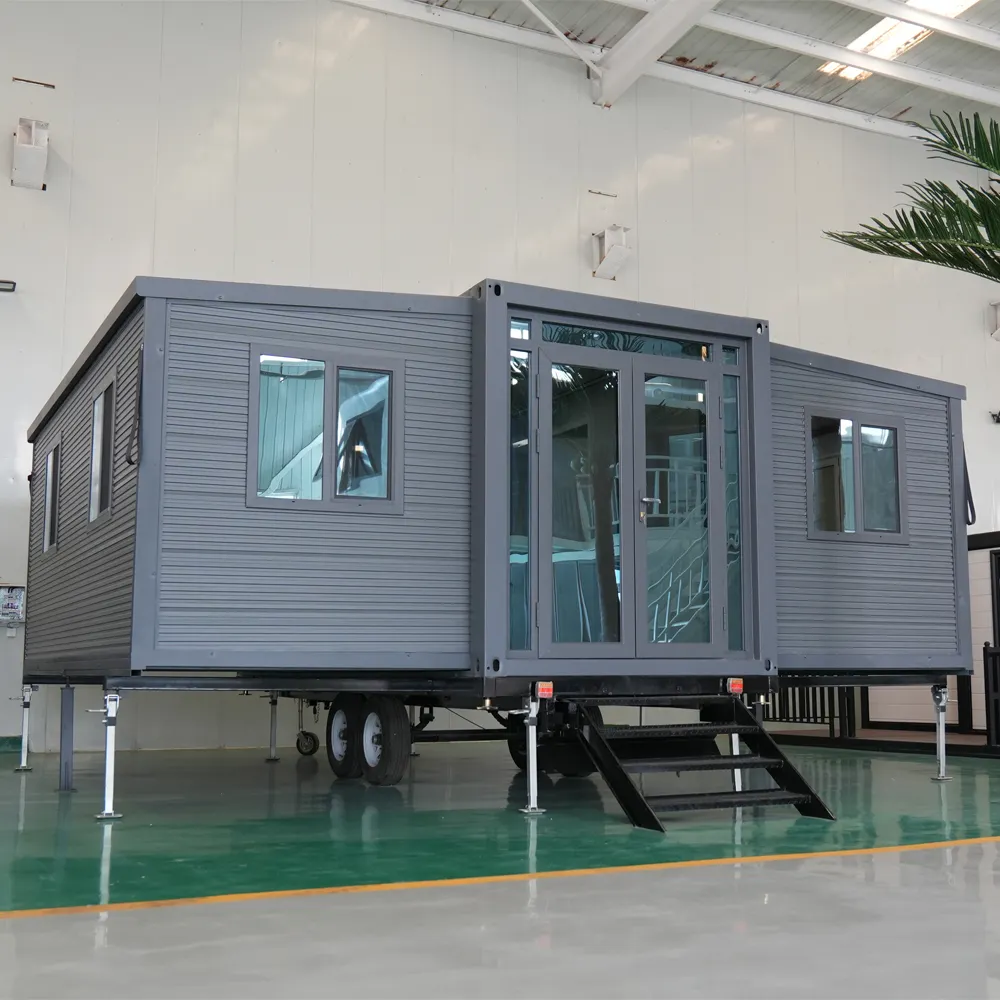ההעברה הגלובלית לחיים מוגמרים
ב khắp העולם, שוקי הדיור מתפתחים כאשר אנשים מחפשים דרכים מהירות, זולות יותר וברות קיימא לבנות בתים. הבית המוגמר בית מודולרי emerged כתשובה מעשית לצרכים אלו, תוך שילוב של עיצוב מודרני עם שיטות בנייה אפקטיות. להבדיל מדיור מסורתי, אשר סומך על כוח עבודה באתר ובזבוז של זמן, הבית המוגמר מיוצר בסביבה מבוקרת לפני שmontage באתר. הגישה הזו מביאה תוצאות אחידות, מקטינה פסולת, ומספקת את הדרישות של בעלי בתים מגוונים. ככל שמחירון וקיימות הופכים להיות עדיפויות גלובליות, הבית המוגמר בית מודולרי gaining הכרה כפתרון דיור מודרני.
הנגישות וה נגישותק
הפחתת עלויות בנייה
אחת הסיבות המרכזיות לגידול בפופולריות של בית מקדונת היא הנגישות הכלכלית. ייצור רכיבים ב заводים מקטין בצורה משמעותית את עלויות העבודה, העיכובים והשימוש המוגזם בחומרים. גורם זה הופך את בתי מקדונת לאפשרות נגישה לאנשים ומשפחות אשר בממוצע לא היו יכולים להרשות לעצמם לבנות בית מסורתי. עם תחזיות כלכליות ברורות ודגמים זולים יחסית, בתי מקדונת מציגים אפשרות להפוך לבעלים של בית לקהל רחב בהרבה יותר.
נגישות רחבה יותר ברחבי אזורי הארץ
בתי ייצור מקדמים גם את הפער בمناطקים שנתקלים במחסור בדיור. עיצובם המודולרי מאפשר להסעתם ולהרכבתם בمناطקים נידחים או עירוניים ביעילות שווה. גמישות זו הופכת אותם למשכו במיוחד למשרדים וארגונים העוסקים בצורך הדיור. בית ייצור מספק לא רק נגישות כלכלית אלא גם נגישות, ומכאן מוכיח כי דיור יעיל יכול לענות על צורכי קהילות מגוונות ברחבי העולם.

יתרונות עיצוב ואופציה להתאמה אישית
אופציות מודרניות וסטייליסטיות
עברו הזמנים שבהם בית מוקד קדם ייצור נחשב לאפשרות זמנית או פחות אטרקטיבית. כיום, העיצובים המודרניים מתאפיינים בפריסה פתוחה, חלונות גדולים וסיומות אלגנטיות. בעלי בתים יכולים לבחור בין אסתטיקה מינימליסטית לבין פרטים יוקרתיים, בהתאם להעדפותיהם. בית קדם ייצור יכול לשקף את מגמות האדריכלות העדכניות, תוך הבנייה בארבע של עלות וזמן בהשוואה לבנייה מסורתית.
תיכניות מותאמות לכל סגנון חיים
סיבה נוספת לפופולריות של בתים מקדונלטים היא היכולת להתאימם. למובילים ניתן לבחור מתיכניות מגוונות ולעצב את המרחב בהתאם לצרכים הייחודיים שלהם. בין אם מדובר במשרד בית נוסף, אזורים גדולים למשפחה או תכונות ידידותיות לסביבה - בית מקדונלט מציע גמישות. כך מבטיחים שמקני הבית לא יצטרכו להתפשר בין פונקציונליות לסטיל, שכן התאמה אישית היא חלק מה תהליך הייצור.
תוקפנות ו אחריות סביבתית
תכונות חסכוניות אנרגטית
קיימות כמה סיבות שמובילות לטרנד של בתי פנימיה מוגמרים. רבים מהעיצובים כוללים בידוד חכם מבחינה אנרגטית, אינטגרציה של פאנלים סולריים וחומרים ידידותיים לסביבה. תכונות אלו לא רק מפחיתות את פלט הפחמן אלא גם מקבלות עלויות שירות נמוכות יותר. לכן, בית פנימי הוא לא רק מקום מגורים נעים אלא גם בחירה אחראית עבור בעלי בתים מודעים לסביבה שרוצים להSENS את אורח החיים שלהם למטרות הקיימות העולמיות.
הפחתת פסולת בנייה
שיטות בנייה מסורתיות יוצרות לעיתים קרובות כמויות גדולות של פסולת, החל מעץ מיותר וכלה בבטון שנזרק. לעומת זאת, בית פנימי בנוי בטכניקות ייצור מדויקות שמפחיתות את הפסולת. סביבת ייצור מבוקרת מובילה לשימוש יעיל בחומרים, ופחתת את ההשפעה הסביבתית. הגישה הירוקה הזו מדברת אל קהלים ואזרחים המעדיפים חיים ירוקים.
יתרונות מעשיים של בתי פנימיה
מהירות הבנייה
אחת ההטבות הבולטות ביותר של בית מקדונת היא הקיצור של משך הבנייה. בניגוד לבנייה מסורתית שאורכת חודשים או אפילו שנים, דגמי מקדונת יכולים להיבנות בתוך שבועות. מהירות זו מועילה למבקשי דיור מיידי ולמפתחים המעוניינים בשיבת הון מהירה יותר. הסיבת למהירות זו היא אחת הסיבות שבגינה בתי מקדונת הופכים לבחירה המועדפת של רבים.
עקביות ובקרת איכות
מכיוון שבתי מקדונת נבנים ב завод בתנאים מחמירים, שליטת האיכות גבוהה בהשוואה לבנייה באתר. כל רכיב נבדק ומאושר לפני המשלוח, מה שמפחית את הסיכון לפגמים או אי-התאמות. למבקשי דיור יש ביטחון בבריאות וב Bezpieczeństwa של בתי מקדונת, כשהם יודעים שהבית יוצר לתקנים מדויקים. אמינות זו מוסיפה לדחיפותם.
הטבות שיקומיות
מרחבים לחיים נוחים ופונקציונליים
בתי פארה הם לא רק פרקטיים אלא גם מעוצבים עם דגש על חיי היום-יום המודרניים. תכנון מרחב פתוח, ניצול יעיל של השטח ופתרונות אחסון חכמים הופכים אותם לנוחים למשפחות ולأفراد. בית פארה ממקסם כל מטר מרובע, ומבטיח פונקציונליות ללא תחושת הצפיפות. המיקוד באיכות החיים הוא אחת הסיבות שבגינה קונים ברחבי העולם נמשכים אל בתים אלו.
התאמה לעתיד
נושאות החיים משתנות, ובית פארה יכול להתאים בהתאם. עיצובים מודולריים מאפשרים הרחבות, שיפוצים או התאמות בהתאם לצרכים המשפחתיים המשתנים. בין אם מוסיפים חדר שינה נוסף, משרד ביתי, או שדרוגים ידידותיים לסביבה – היציבות של בית פארה מובטחת לאורך זמן לאחר הרכישה הראשונית. גמישות זו תורמת לפופולריות העולמית הגוברת שלו.
Тенденציות עתידיות בישובים מנהריים
אינטגרציה של חכם בית טכנולוגיה
עתיד בתי הפרסה נמצא באינטגרציה טכנולוגית. תכונות כמו תאורה אוטומטית, מערכות יעילות באנרגיה וביטחון מתקדם הופכות להיות סטנדרט. טכנולוגיות אלו מעצימות נוחות ומצמצמות את צריכה האנרגיה. בית פרסה מתאים במיוחד לחדשנות זו, מאחר שעיצובים מודולריים מאפשרים שילוב קל של מערכות חדשות, מה שעושה אותם לבתים מוכנים לעתיד.
ביקוש גלובלי מתפשט
בתי פרסה כבר אינם אופציות מוגבלות. מאסיה ועד אירופה והאמריקות, הביקוש גדל, שכן אנשים מחפשים פתרונות לאתגרי הדיור בערים ו לדאגות סביבתיות. עם הכרה מצד ממשלות ומשווקים על פוטנציאלם, בית הפרסה עומד לשחק תפקיד מרכזי בשווקי הדיור הגלובליים. התאמה שלו למגוון אקלימים, תקשורת ו אורח חיים מובטחת פופולריות לטווח הארוך.
שאלות נפוצות
מדוע בית פרסה זול יותר מבתים מסורתיים
בתים מוכנים מיוצרים ב заводים בתהליכי ייצור מותאמים שמקצרים על עלויות עבודה, עיכובים ושאריות חומרים. יעילות זו מקטינה את העלות הכוללת ומשמרת את האיכות.
האם ניתן להתאים אישית בית מוכן
כן, ניתן להתאים אישית בית מוכן באמצעות תכנונים שונים, גימורי פנים ואופציות ידידותיות לסביבה. התאמה זו מבטיחה לממשיכי בית להתאים את בתיהם להעדפותיהם הייחודיות.
האם בתים מוכנים הם ברת-תוקף
בהחלט. בתים מוכנים נוטים להשתמש בחומרים ידידותיים לסביבה, בידוד מתקדם ובאופציות לאנרגיה מתחדשת. ייצורם גם מקטין את כמות הפסולת, מה שעושה אותם לאופציה אחראית סביבתית.
כמה זמן לוקח בנייה של בית מוכן
בממוצע, בית מוכן יכול להסתיים תוך שבועות לעומת החודשים והשנים הדרושים לבנייה מסורתית. המהירות הזו היא אחת הסיבות המרכזיות לפופולריות שלהם.

